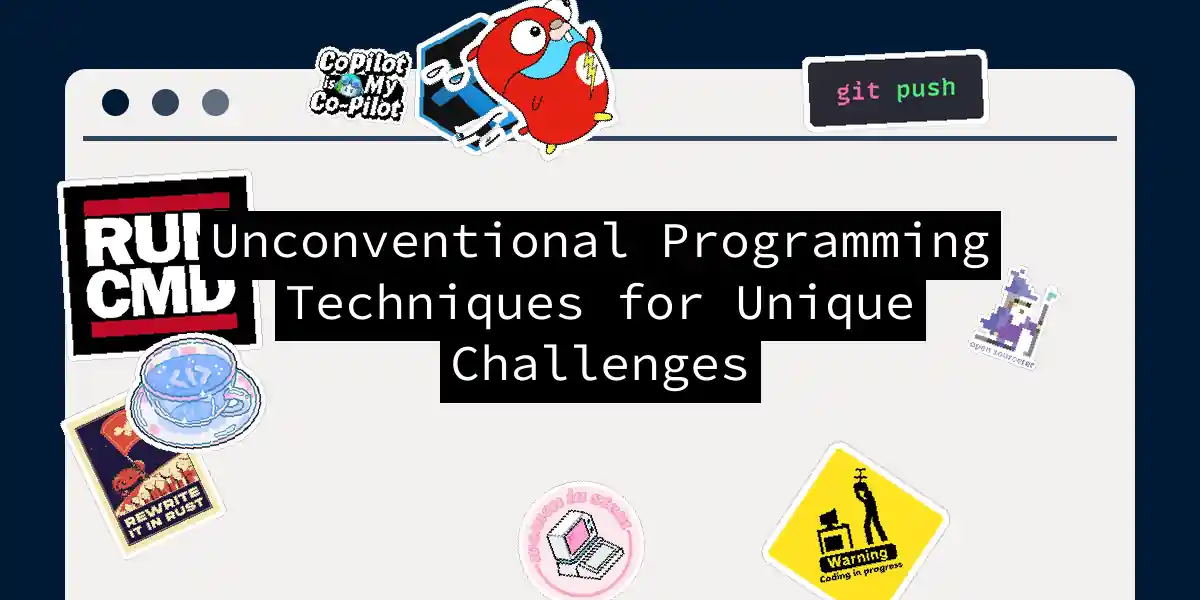The Uncharted Territories of Computing
In the vast and ever-evolving landscape of software development, there are times when the conventional methods just won’t cut it. This is where unconventional programming techniques come into play, offering innovative solutions to unique challenges. From using billiard balls and dominoes to compute, to programming languages that resemble cooking recipes or the works of Shakespeare, these approaches are not just intriguing but also powerful tools in the right contexts.
Physical Computing: Billiard Balls and Dominoes
Imagine a world where computation is not confined to silicon chips but can be performed using everyday physical objects. This is the realm of mechanical computers, such as billiard-ball computers and domino computers.
Billiard-Ball Computers
A billiard-ball computer uses the motion of spherical billiard balls to perform computations. Here’s how it works:
- Paths and Signals: The wires of a Boolean circuit are represented by paths for the balls to travel on.
- Gates and Collisions: The presence or absence of a ball on a path encodes the signal on that wire, and gates are simulated by collisions of balls at points where their paths intersect.
This model is more than just a curiosity; it demonstrates that computation can be achieved through physical interactions, highlighting the versatility of computational principles.
Domino Computers
Domino computers use standing dominoes to represent the amplification or logic gating of digital signals. Here’s a simplified example:
In this setup, the falling of one domino triggers the next, simulating a logical operation. This method is not only educational but also shows how simple physical systems can be harnessed for computation.
Reservoir Computing
Reservoir computing is another unconventional approach that leverages the dynamics of a fixed, non-linear system (the reservoir) to process input signals. Here’s a step-by-step look:
- Input Mapping: Input signals are mapped into a higher-dimensional computational space through the reservoir.
- Reservoir Dynamics: The reservoir, which can be virtual or physical, consists of individual non-linear units connected in recurrent loops.
- Readout Stage: Training is performed only at the readout stage, as the reservoir dynamics are fixed.
This framework allows for simple and fast learning algorithms and can be implemented using various physical systems, including classical and quantum mechanical ones.
Esoteric Programming Languages
Esoteric programming languages are designed to test the boundaries of what we consider “normal” in programming. Here are a few examples that showcase their unique characteristics.
Befunge
Befunge is a language that allows the instruction pointer to move in multiple dimensions through the code. Here’s an example of a “Hello World” program in Befunge-93:
"dlroW olleH">:v
^,_@
This language is known for its complexity and the challenge of compiling it.
Chef
Chef is a stack-oriented language that makes programs look like cooking recipes. Here’s a “Hello World” example:
Hello World Soufflé.
Ingredients.
101 eggs
111 cups oil
1 cup milk
1 cup flour
1 teaspoon salt
Instructions.
Preheat oven to 350°F.
Break eggs into mixing bowl.
Add oil, milk, flour, and salt.
Mix until smooth.
Pour into baking dish.
Bake for 30 minutes.
Serve hot.
This language combines the practicality of cooking with the logic of programming, making it both fun and educational.
LOLCODE
LOLCODE is based on the LOLCats phenomenon and uses a syntax that resembles the speech of lolcats. Here’s a “Hello World” example:
HAI
CAN HAS STDIO?
VISIBLE "HAI WORLD!"
KTHXBYE
This language is a favorite among those who enjoy the whimsical side of programming.
Chaos Computing
Chaos computing utilizes chaotic systems to perform computations. Here’s how it works:
- Chaotic Systems: These systems can be used to create logic gates and can be rapidly switched between different patterns.
- Fault-Tolerant Applications: Chaos computing is useful for fault-tolerant applications and parallel computing due to its inherent stability and adaptability.
Stochastic Computing
Stochastic computing represents continuous values as streams of random bits and performs operations using simple bit-wise operations on these streams. Here’s a step-by-step example:
- Bit Stream Generation: Generate streams of random bits.
- Bit-Wise Operations: Perform operations such as AND, OR, and NOT on these streams.
- Precision Increase: The precision of the computation increases as the bit stream is extended.
This method is particularly useful in iterative systems where faster convergence is needed.
Practical Applications and Examples
Swarm Robotics
Swarm robotics, inspired by the emergent behavior of social insects, involves coordinating multiple robots using simple individual rules to produce complex group behaviors. Here’s a simplified sequence diagram for a swarm robotics system:
This approach promotes scalability and can be applied in various fields such as search and rescue missions.
Ternary Computing
Ternary computing uses ternary logic (base 3) instead of the more common binary system. Here’s an example of how ternary logic works:
- Trits: Ternary digits can be defined in several ways, including unbalanced ternary, fractional unbalanced ternary, balanced ternary, and unknown-state logic.
- Qutrits: Ternary quantum computers use qutrits instead of trits.
Ternary computing has been proposed for high-speed, low-power consumption devices, making it an interesting area for research.
Conclusion and Call to Action
Unconventional programming techniques are not just novelties; they offer unique solutions to complex problems and can inspire new ways of thinking about computation. Whether you’re intrigued by the mechanical elegance of billiard-ball computers or the whimsical nature of LOLCODE, there’s something here for everyone.
As software developers, we should always be open to exploring new paradigms and methods. These unconventional techniques can not only solve specific challenges but also enrich our understanding of what computation can be.
So, the next time you’re faced with a problem that seems insurmountable, consider stepping outside the box and into the world of unconventional computing. You might just find the solution you’ve been looking for, and along the way, you’ll have a lot of fun.
Final Thoughts
In the words of Alan Kay, “The best way to predict the future is to invent it.” Unconventional programming techniques are not just about predicting the future; they are about inventing it, one innovative step at a time.
